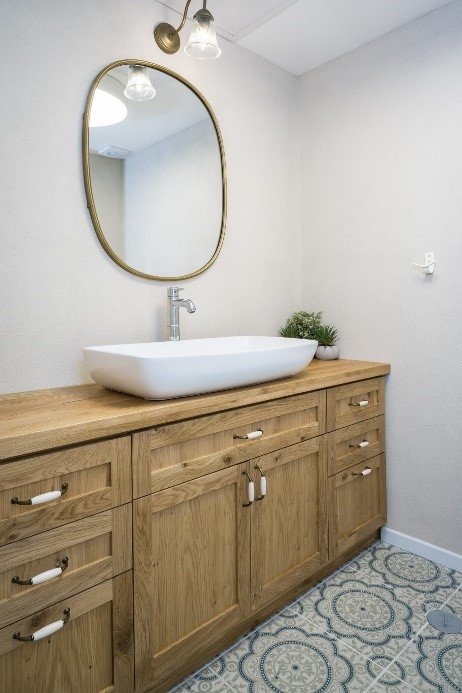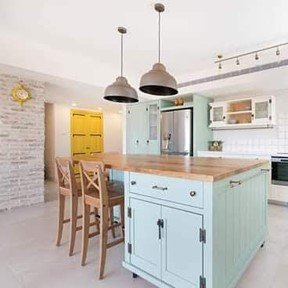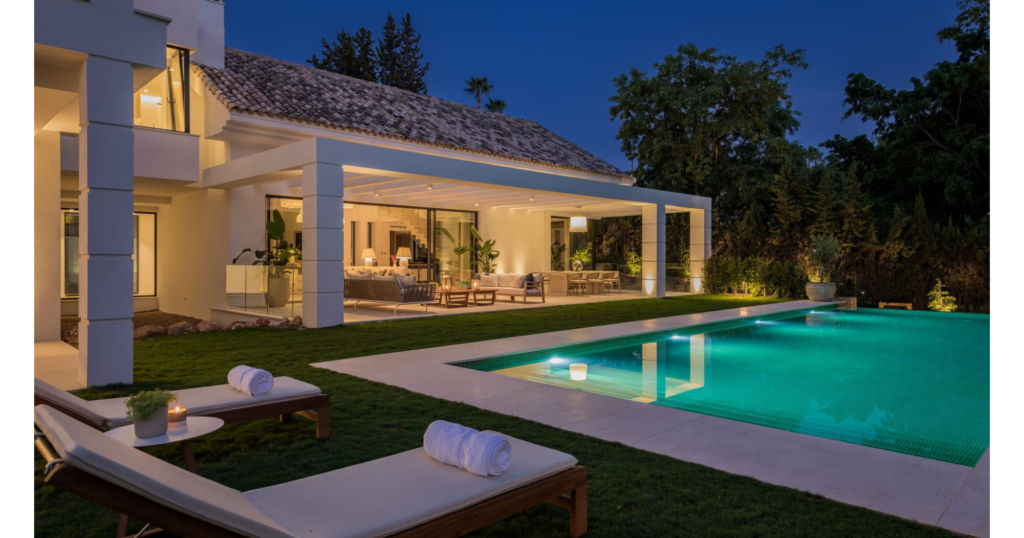For example, a parent’s bedroom seeking a sense of softness and purity can achieve this by using shades of white on the room’s walls, furniture, and other elements. Excessive use of white can convey sterility, coldness, and emptiness, so it’s essential to incorporate colorful elements that add depth, growth, and vitality, such as green or purple.
A teenager’s room, which may sometimes experience chaos, can benefit from incorporating shades of yellow, as they convey joy, lightness, an uplifted spirit, and success. However, it’s essential not to overdo it, as an excess of yellow can convey restlessness and fickleness. Therefore, it’s advisable to complement it with other colors. For instance, warm tones like red, which symbolizes connection to the earth and warmth, can be combined with green elements that evoke a sense of blossoming.
Another example is a bathroom designed in a warm and inviting rustic style. The design accommodates the needs of a family with an emphasis on practicality. The selected materials are layered to create a cozy and non-clinical atmosphere. Geometric tile patterns on the walls evoke childhood memories in colors that convey stability, tranquility, blossoming, health, and hope.

Here is a guide to help you focus and refine your feelings, emotions, and experiences in your personal space:
- **White**: Conveys purity, innocence, simplicity, romanticism, and spirituality. Excessive use can convey sterility, coldness, and emptiness.
- **Gold**: Symbolizes wealth, splendor, and luxury. An excess of gold can convey arrogance and ostentation.
- **Black**: Represents formality, elegance, and authority. Excessive use can convey emptiness and gloom.
- **Gray**: Signifies neutrality, conservatism, and stability. Too much gray can convey sadness and passivity.
- **Brown**: Conveys a connection to the earth, work, and solidity. Excessive use can convey servitude and lack of energy.
- **Green**: Emanates nature, growth, new life, blossoming, and ecological awareness. An excess can symbolize jealousy and conflict.
- **Yellow**: Radiates sunlight, joy, lightness, productivity, and a morale boost. Too much yellow can convey betrayal and suspicion.
- **Orange**: Conveys ambition, creativity, optimism, and openness. Excessive use can convey arrogance and disdain for others.
- **Red**: Represents passion, love, pleasure, warmth, and affection. An excess of red can convey anger, warning, and aggressiveness.
- **Pink**: Emanates sensitivity, tenderness, softness, and romance. Too much pink can convey excessive sensitivity, vulnerability, and hurt.
- **Purple**: Symbolizes royalty, spirituality, devotion, righteousness, and wisdom. An excess can convey confusion and depression.
- **Blue**: Signifies calmness, peace, serenity, and nobility. Too much blue can convey detachment and heaviness.
For example, for a bedroom, if you want to create a sense of security and growth, you can use a classic rustic English design with checkered wallpaper that forms a symmetrical geometric pattern, which creates a sense of calm and security. Combine this with colors that convey blossoming, growth, tranquility, and health.
This bedroom belongs to a woman who has recently gone through a breakup and wanted to feel safe and experience personal growth.

Certainly, here are some practices to improve the atmosphere and create a positive impact when using colors in interior design:
- **Start with a Neutral Base**: Begin with a neutral color palette as the foundation for your space. Neutrals like whites, beige, and grays provide a versatile background that allows other colors to shine. They offer a sense of calm and flexibility and serve as a canvas for introducing other elements into the room.
- **Incorporate Accent Colors**: strategically introduce vibrant accent colors to add visual interest and evoke specific emotions. Choose colors that resonate with the desired atmosphere for each room. For instance, warm tones like oranges and yellows can energize and inspire creativity, while cooler blues and greens promote tranquility and serenity.
- **Consider Cultural Significance**: Different cultures associate colors with specific meanings and symbolism. Explore and respect cultural preferences when designing spaces, especially if you aim to create an inclusive and welcoming environment.
By incorporating these practices into your interior design, you can create spaces that not only look appealing but also evoke the desired emotions and atmosphere for each room.
Certainly, here are some color combinations to consider when designing your space:
- **Analogous Colors**: Choose colors that are adjacent to each other on the color wheel. Analogous color schemes, such as using shades of blue and green or warm tones like red, yellow, and orange, create a cohesive and calming atmosphere.
- **Complementary Colors**: Pair colors that are directly opposite each other on the color wheel. Complementary color schemes, like blue and orange or purple and yellow, provide vibrant contrast and energy, making the space dynamic and visually appealing.
- **Monochromatic Tones**: Stick to variations of a single color. Monochromatic color schemes convey a sense of unity and simplicity, offering a sophisticated and elegant look while maintaining a calm and balanced atmosphere.
For example, in a warm rustic kitchen adorned with materials like stone, metal, and wood, the combination of earthy tones symbolizes a refreshing blend that expresses hope, joy, energy, movement, growth, and a connection to nature, represented by green and sunlight.

By considering these color combinations, you can create a harmonious and visually appealing environment that aligns with your desired emotions and atmosphere.
- Colors to Avoid and Their Impact on Mood:
While color choices are subjective, there are certain considerations regarding colors that may not be recommended for specific purposes:
– Bright Reds, Dominating: Strong reds can evoke strong emotions and stimulate energy, making them less suitable for spaces intended for relaxation, such as bedrooms or meditation areas. However, combining softer shades of red, like pastel pink, can still convey warmth without overwhelming the senses.
– Intense, Bold Black: While black can add an element of elegance and sophistication, excessive use of dark or intense black shades can make a space feel heavy and gloomy. Balance is key when incorporating black, either as an accent or in combination with lighter shades.
– Clashing Color Combinations: Avoid combining colors that clash in terms of intensity or hue, as they can create visual discord and contribute to feelings of unease. For example, pairing vibrant, glossy red with bright green may result in a jarring effect rather than a
Summary:
In interior design, colors have the power to shape consciousness, the mind, mood, and nurture the soul and personality within a space. By adhering to recommended working methods, examining suitable combinations, and paying attention to the potential influence of different colors on mood, you can create a harmonious and inspiring environment. Remember, colors have immense potential to transform and enrich our surroundings, so let your creativity guide you in creating spaces that bring joy and comfort.
It is advisable to consult with a professional if you are unsure about a specific color combination or need advice on color adaptation for a particular space or home. I would be happy to provide guidance.






